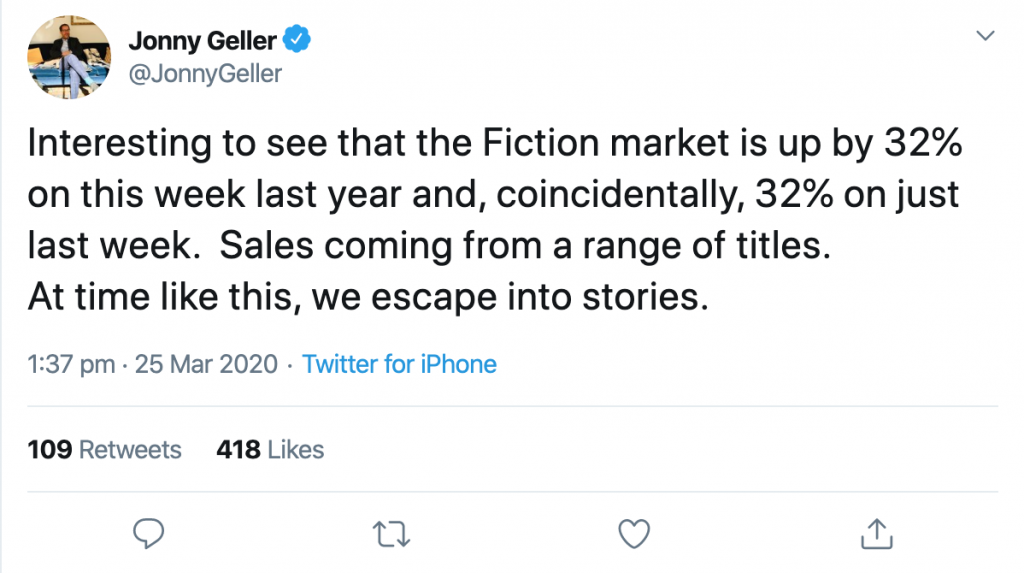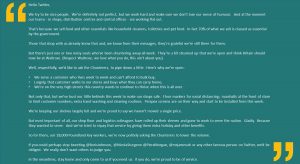COVID-19 is changing the rules of communication. This article summarises what we’ve figured out so far. We share the five principles for storytelling in a crisis, and a worked example, based on a cyber threat.
Updated 4th June 2021
In the wake of the pandemic, the rulebook of working culture and practice is being rewritten in real time. The role and rules of communication are changing in parallel. Cohesive is a PR and Content Marketing Agency, and so we’re part of this new communication landscape. This update provides clearer guidance on how to communicate during this time of rapid cultural change and business uncertainty.
We’ll be guided by the data…
Let’s check in with you. This may be all too real, but put yourself in the position of needing to communicate in a crisis, and then ask yourself: on my best days, which is me?
Guarded, Typified by
- We’re not in a position to be certain…
- We can buy some time
- “We’re not making any statements right now.”
Open, Typified by
- People deserve to know…
- Speculation is mounting
- “Here are all the facts at our disposal”
Directional, Typified by
- People need to understand the risk…
- Let’s be clear about what we know
- “This thing has happened. These consequences are certain. These few, we can safely rule out. We’re working on removing as much uncertainty as possible.”
Denial, Typified by
- There are bigger, more complicated, issues at stake…
- Nothing to see here
- “In the fullness of time, people will understand that…”
We’re pretty sure you’re not in that fourth group – denial. You’ve seen how swirling rumours take on a life of their own in the absence of information, or the presence of conflicting reports. But if you’re like us – human, fallible, occasionally fearful – there will have been times when any one of the other three might have looked like the best option.
All four have been deployed by governments and agencies across the globe as they’ve tried to communicate the story of the unfolding COVID-19 crisis. It’s our conclusion that those governments that have done the best fell broadly into the directional category, and our case study is the New Zealand government’s response lead by Jacinda Ardern. In our article on Stories to divide and unite us we wrote:
"Jacinda Ardern believes in and engages with the compassion in all of us, using empathy. Her narrative is about shared wellbeing for all. Her style is clear and consistent, and she delivers both the soothing and the sobering messages with equanimity and crystal clarity. New Zealanders feel she’s got their backs. That she stands among them, rather than preaching to them."
Empathy is vital. It is the voice of the helper. It’s the narrative of insight, integrity and generosity. Empathy is an instinct that instructs you to consider the needs of all stakeholders, not just because is the right thing to do, but because ultimately it’s also the most effective. Equanimity – the other key skill – isn’t so much about balance as balancing. Balance is a temporary thing, past tense pretty much the instant you achieve it. Balancing is a dynamic process that adjusts as the crisis unfurls, information is updated and perspectives shift. Put those two together, and you’re already being directional.
We’ve been involved in communicating several crises over the last 12 months, and from experience the directional approach translates extremely well into everything from cyber attacks at listed companies, to unplanned exits of high profile executives. Best appreciated in practice, we’ve laid out some guidelines from the perspective of a cyber breach style crisis, to finish this article.
Why it’s good to tell stories in a crisis
Acting on the assumption that you’re doing the right thing to start with, we should have a quick rundown on the basics. What, from a communication standpoint, does doing the right thing look like? In this to-the-point blog Jay Acunzo points out a clear dichotomy.
"...to figure this out, we don’t need a different page of the playbook. We don’t need a different playbook, either. We need to ditch the playbook mentality altogether and act like people."
That’s confirming that you and your instincts may be the best guide to figuring out the sweetspot and edges of your directional approach.
From another perspective here’s literary agent @jonnygeller :

Jonny’s said it for us. In times of crisis, we turn to stories. Humans are hardwired for storytelling. Have you noticed that you have a running narrative in your head, starring you as the central character in the ongoing story of your life? It’s how you experience being you. Without even trying, and often without you noticing, your brain is constantly joining up random facts, sensations and emotions into a seemingly sensible narrative which flows into that story.
The process is just as efficient in reverse – deconstructing stories back into soundbites and feelings and firing them into your subconscious, instantly creating new connections, emotions and memories. That’s how storytelling cuts through the incessant noise and uncertainty, and helps your audience to focus and engage. In times of crisis, it’s essential to invest in stories and storytelling.
What stories? This, from the Harvard Business Review:
"Worried consumers—even in the comfortably well-off and live-for-today segments—see familiar, trusted brands and products as a safe and comforting choice in trying times. Reassuring messages that reinforce an emotional connection with the brand and demonstrate empathy (for example, by conveying a sense that “we’re going to get through this together”) are vital."
Five principles for building directional stories
1. Think about your audience
You may find this situation scary. You may find it cathartic or inspiring. But ultimately, what do you want your community to feel? You’re writing for them, not your CEO or your accountants.
"I’m inundated with tired messages of support from brands I interacted with once upon a time. They might be well intentioned, but they’re just getting in the way"
2. Listen to the bigger narrative
Don’t be tone deaf. Your world is bigger than the narrow confines of your crisis. Understand how that narrative will affect perception of your communication. You can use it to great advantage.
This – from Poundland

3. Help
Let people know your situation or offer; how they are affected, or stand to benefit: where to reach you. That’s all the selling you need to do. Don’t offer promotions. Don’t issue denials. Share genuinely useful stuff. Let your honesty and integrity guide you.
Here’s Heinz, keeping it simple:

4. See it from the human perspective
Chances are you’re reading this at home still, maybe in your jammies. The kids are holding their drawings up for your sales review to mark. But that’s perfect – because that’s everybody right now. Write from the heart of that mother, partner, dog walker and ninja shopper that you are.
You probably saw Prof. Robert Kelly’s interview with the BBC gatecrashed by his kids? Here’s the bookend on that story.

5. Know it will be out of date in a week
Change isn’t going to stop. But that doesn’t matter. There’ll never be a better day. There is no other moment but this one. Keep forecasts short term and list your assumptions. Make intentions, but not promises. Don’t tell people what they want to hear, but what they need to know.
@RyanAir – often accused of being tone deaf – standing out from the crowd of budget airlines for the right reasons.

We’ve been hacked!
Okay, let’s get to a bit of a worked example of the directional approach in action. We’ll use a cyber crime as our canvas, because you’re highly likely to suffer one, and they are always serious.
You wake up one morning to a call from your head of IT saying your company has been hacked. An anonymous group is claiming to have stolen sensitive information, and demanding a ransom or they’ll start selling that information on the dark web. This is scary. People will be panicking – no doubt. You won’t be short of opinions on what to do. People will want certainty before they act. They won’t have it – or at least not for a long time. Except this one certainty – the story is going to find its way into the public domain. Attacks like this have a thousand consequences both large and small. Every one of them impacts on a person. So it’s gonna leak. Your job is to tell your story, not have it told for you. The advantage of a directional stance is that you don’t need certainty of outcome before you act.
Your first communication
-
- Tells your world that you’ve been attacked |The exact detail is a judgement call for you
- Says what you know, with no speculation or forward-looking statements
- Outlines your response so far, and steps you’re taking for the future
- Alerts staff and third parties to what action they can take to protect themselves
- Tells partners and customers how to do business with you as you work through the problem.
- Makes a commitment to further updates as more becomes known.
Next step – Scenario Planning
Imagine a spreadsheet table. Column headers might be: Our Business; Our People; Our Partners. Row titles up the left hand side are all risk based: Low; Medium; High; In each cell, a recipe. Some examples:
Low Risk x Our People | ‘Non-identifiable information taken’
Medium Risk x Our Partners | ‘Personally identifiable information of partner personnel’
High Risk x Our Business: | ‘Critical systems passwords taken’
Your risk manager or operations director will need to help establish and populate those categories.
Create a Storybook
You can now – in advance – create narratives for each of those scenarios. The building blocks of each narrative are:
-
- Here’s what we know (or have learned since our last communication)
- These are the actions you can take
- This is what remains to be understood
- This is our process to moving forward
The what, when and how much is going vary massively from case to case. Broadly, if changes in the situation causes changes in risk level – in either direction – there’s a case to communicate. Keep it factual, helpful, empathetic. Don’t make predictions. Don’t give unwise assurances. If you can, aim for a regular cadence to your communications. It’s reassuring.
Over time, in serial fashion, the story of your cyber breach is told – by you. It smacks of honesty, transparency and endeavour. It’s obvious that you are acting to protect everyone involved, not just the organisation and its reputation. You accept criticism. You stick to facts, actions, and outcomes. It won’t be perfect, but it will be all yours.
Come the last chapter, it’s likely there will still be much left to be resolved. You will not have certainty around every eventuality. Call time on the project as when you know that everything reasonable has been done to mitigate future risk. Say as much. Then move on.
Summary
During the pandemic – a time of intense pressure and great uncertainty – organisations and administrations that communicated through stories were better able to sustain attention and build trust. Their posture was empathetic, measured, open and fact-driven, for which we’ve coined the term directional. This is the stance that we at Cohesive routinely advise clients to take when communicating crises of their own. We’ve outlined the operating principles, and provided an example in the form of a cyber breach.
Clearly, there’s lots more to explore. We’d love to hear what you think. Leave us a comment below, or reach out any of the channels listed at the bottom of this page.
*Harvard Business Review 2009: How to market in a downturn






I can’t agree more and thank you for the useful tips which we will use in our next newsletter 🙂
Hi Manuela. Glad you’re finding it helpful. We’re keeping a bit of a log of the best and worst examples we come across. Please share yours?
Andy
Hi Andy,
Yes that was very clear and as a small outfit we have been trying really hard to get the right tone of message to clients and potential clients.
We all (lots of us) apparently nowadays have the attention span of a Gnat. (is that unfair on the Gnat). I think a lot of people have been jumping on the DIY video communication route and mostly doing it badly. But we could not tell them that. Their intentions are good but some of the deliveries create too much noise/distraction and hence poor engagement for us with limited attention spans,
I think you guys might need to consider how you can use video to help your clients or advise them how to use it. So that a few really key messages get underlined with some After Effects/animation or a MD says something that comes from the heart…Nice when you see Heinz getting it right, there is a story that in the’Big Crash’, Kellogs got it right and came out on top as the leading cereal brand.
John
Hi John – thanks for taking the time to read and respond. Here’s our take:
There’s no doubt that video grabs attention and then helps forge a strong connection. The starting point for us would be ‘Does what I’m about to record provide insight, or interruption? Is it helpful, sincere, entertaining, or copycat and cynical?’ If the story isn’t coming from the right place, no amount of post-production makes it better. And often that raw, handheld footage is as pure and authentic as storytelling gets. It says ‘this is from me, to you, in this moment’.
Certainly though in a more formal setting, or when working with someone that isn’t relaxed in front of a camera, there’s plenty of scope for skilful direction and editing.
So keep up the good work, good luck and stay safe – Andy